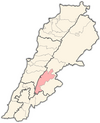Aammiq
 From Wikipedia - Reading time: 8 min
From Wikipedia - Reading time: 8 min
Aammiq is a village in the Western Beqaa District in Lebanon. It is also the name of an archaeological site.
Archaeology
[edit]| Location | southwest of Zahle Aammiq Wetland, Lebanon |
|---|---|
| Coordinates | 33°43′53″N 35°47′20″E / 33.731431°N 35.788983°E |
| Type | Tell |
| Part of | Settlement |
| History | |
| Founded | c. 12000 BC |
| Abandoned | c. 4500 BC |
| Periods | Natufian, Neolithic, Chalcolithic |
| Site notes | |
| Excavation dates | 1963, 1965, 1971 |
| Archaeologists | M. Cavalier Jacques Cauvin J. Besançon & Francis Hours |
| Condition | ruins |
| Public access | Yes |
Aamiq or Aammiq II is an archaeological site southwest of Zahle in the Aammiq Wetland, Beqaa Valley, Lebanon.[1]
It was first excavated by Jacques Cauvin in 1963, then again by M. Cavalier in 1964, 1965 by Lorraine Copeland and Peter Wescombe and Jacques Besançon & Francis Hours in 1971.[2]
Two periods of inhabitation were found, the first period between 12000 and 10200 cal. BC was Natufian or perhaps preceramic neolithic where a skeleton was found covered with red ochre. Tools with agricultural purpose included mortars, grinders and stoneware basalt pestles. Other brown flint lithics recovered include a triangle, blades, scrapers and picks, tools suggested pre-natufian occupation. A late neolithic period was also detected at around 5000-4500 cal BC (Ubaid period) similar to late neolithic Byblos.[3] Ceramics found included some Chalcolithic sherds and lithics included Canaanite blades, axes and adzes, a long, polished plano-convex flint hatchet; many large flakes and blades and sickle elements. A fragment of a stalked arrow is the only trace of occupation between the periods, Chalcolithic occupation followed the older occupation at the edge of the marsh at Mallaha.[4]
The results of a pollen core from Aamiq was published in 2008 suggesting the area was used for grazing in the neolithic while the Lebanon and Anti-Lebanon mountains were being deforested. This is supported by Heavy Neolithic tools manufactured in specialized workshops such as Kamed el Loz I, Souwan and Wadi Msı'l el Hadd and a special design of flint called an Orange slice found at sites like Majdel Anjar I, Dakwe I and IIHabarjer III, Qaraoun I and II, Kefraya, and Beı'dar Chamou't.[5]
References
[edit]- ^ Francis Hours (1994). Atlas des sites du proche orient (14000-5700 BP), pp. 33-34. Maison de l'Orient méditerranéen. ISBN 978-2-903264-53-6. Retrieved 3 April 2011.
- ^ Hours, F., Copeland, L., Aurenche, O., Les industries paléolithiques du Proche Orient, essai de correlation. IV. Épipaléolithique, L'Anthropologie, 77, 437-496, 1973.
- ^ Copeland, L. Wescombe, P.J., Inventory of Stone-Age-Sites in Lebanon I & II, Mélanges de l'Université Saint Joseph, 41/2 & 42/1, Beirut, 1965/66.
- ^ Copeland, L., Natufian Sites in Lebanon in Bar-Yosef and Valla (eds.), The Natufian Culture in the Levant, 27-42, 1991.
- ^ L. Hajar, M. Haı¨dar-Boustani, C. Khater, R. Cheddadi., Environmental changes in Lebanon during the Holocene: Man vs. climate impacts, Journal of Arid Environments xxx, 1–10, 2009.
 KSF
KSF
